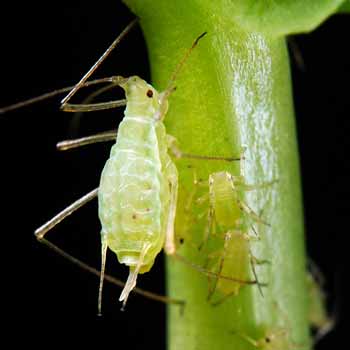Scout for aphids before shipping greenhouse plants
Greenhouse growers are getting unexpected guests on outgoing plants: aphids.
 In the last week, quite a few greenhouse growers found that aphids had become a problem very quickly. This is because of the warm, sunny weather and high temperatures in the greenhouse. Under warm conditions, aphids can complete a generation in seven to 10 days, and each female may produce more than 50 larvae which are born live. This means that a few aphids can become a problem quickly in warm weather.
In the last week, quite a few greenhouse growers found that aphids had become a problem very quickly. This is because of the warm, sunny weather and high temperatures in the greenhouse. Under warm conditions, aphids can complete a generation in seven to 10 days, and each female may produce more than 50 larvae which are born live. This means that a few aphids can become a problem quickly in warm weather.
Check plants carefully for white “dandruff,” the shed skins of molting aphids, on infested leaves or below aphid-infested leaves and shoots. For photographs of the three most common species found in the greenhouse and notes on key features, see “Greenhouse Aphid Management” from Cornell University.
If you find aphids and need to treat plants before they are shipped, consider drenching the soil of infested plants with Marathon, Flagship or Safari. Because aphids are sucking insects, drenches are highly effective. Allow three to five days for the drench to work. If drenching is not practical, spray infested plants with one of the following insecticides: Aria, Orthene, Distance, Endeavor or Precision. The last three are insect growth regulators that interfere with moulting, so they will take a few days to work.
For extra activity, you can tank-mix one of the nicotinoid insecticides (Marathon, Flagship, Safari or Tristar) with Orthene, Distance, Endeavor or Precision. Before tank-mixing, mix a small amount of the insecticides together in a glass jar to make sure there are no problems with compatibility (clumping or sludge-forming). Also, spray a few plants first to make sure the amount of spray residue is tolerable and wait at least 24 hours to make sure there is no damage to sensitive plants, especially if they are flowering.
Photo credit: Wikipedia
Dr. Smitley's work is funded in part by MSU's AgBioResearch.



 Print
Print Email
Email

